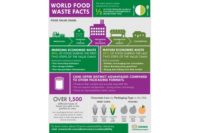Everyone should know Kit Kat chocolate bars—but did you know the wafer in the center is actually made from broken Kit Kat bars? Kit Kat manufacturers leave no bar uneaten. If quality assurance deems that a certain Kit Kat is not up to standards, it will go in the reject pile, ready to be crushed and used to fill other Kit Kats.
It’s predicted that the global population will reach 9 billion by 2050, and feeding this many people could mean increasing food production by as much as 60 percent. However, we first need to reduce the estimated 30 percent of waste currently evident in the supply chain.
According to WRAP, ready meals and chilled products generate up to 12 percent of the total waste arising in the food and drink supply chain. This includes trimmings, rejects and packaging. There are certain factors that are hard to control, like a sudden change in the weather, but there are many variables that you can have a say on.
If certain waste can't be prevented, can it be returned to the process just like the broken Kit Kats? From re-using pastry trim, to using offcuts for another product, there are impressive waste and cost savings to be had. But what about packaging, how can you minimize waste in this area?
You may outsource your wrappers and containers from your regular supplier, but the waste generated by this supplier inevitably becomes your waste, which ultimately effects your reputation and likelihood of getting your product on the supermarket shelves. With the likes of Morrison's boasting a 421 tonne waste reduction in 2011, it's clearly on the big four's agenda.
This is where aluminium packaging shines. As an endlessly recyclable material, offcuts generated from foil tray production can simply be sold to a recycling plant, to be melted and molded into another sheet of aluminium, without losing any quality. At Advanta (advantapack.com), for example, every ounce of aluminium that enters the factory either leaves as a foil tray or is compacted onsite and sent on its way to be recycled and reused—no zero waste.
By choosing aluminium, you're not just reducing the waste that goes to landfill, but also your carbon footprint. According to Alupro, recycling aluminium saves around 95 percent of the energy needed to make the metal from raw materials. Staggeringly, these means recycling one tonne of aluminium saves nine tonnes of CO2 emissions.
Packaging choice also has a huge impact on the shelf life of your product, because closer use-by dates resulting in a higher chance of the consumer putting the product in the bin. Using modified atmosphere packaging or improved seal integrity techniques reduces the risk of food wastage. Smoothwall foil trays are a particularly good option to use with gas flushing techniques to extend shelf life. Equally, these trays are highly robust, meaning the product is protected from damage on its way to the retailer.
It's time for more businesses to assess their supply chains and make themselves a highly reputable and socially responsible option for potential customers. Get your staff engaged to help drive food and packaging waste out of your business. Educate them on the financial and environmental strain that workplace waste brings. Think like the Kit Kat manufacturers, who leave no Kit Kat uneaten and select foil as their packaging of choice.




